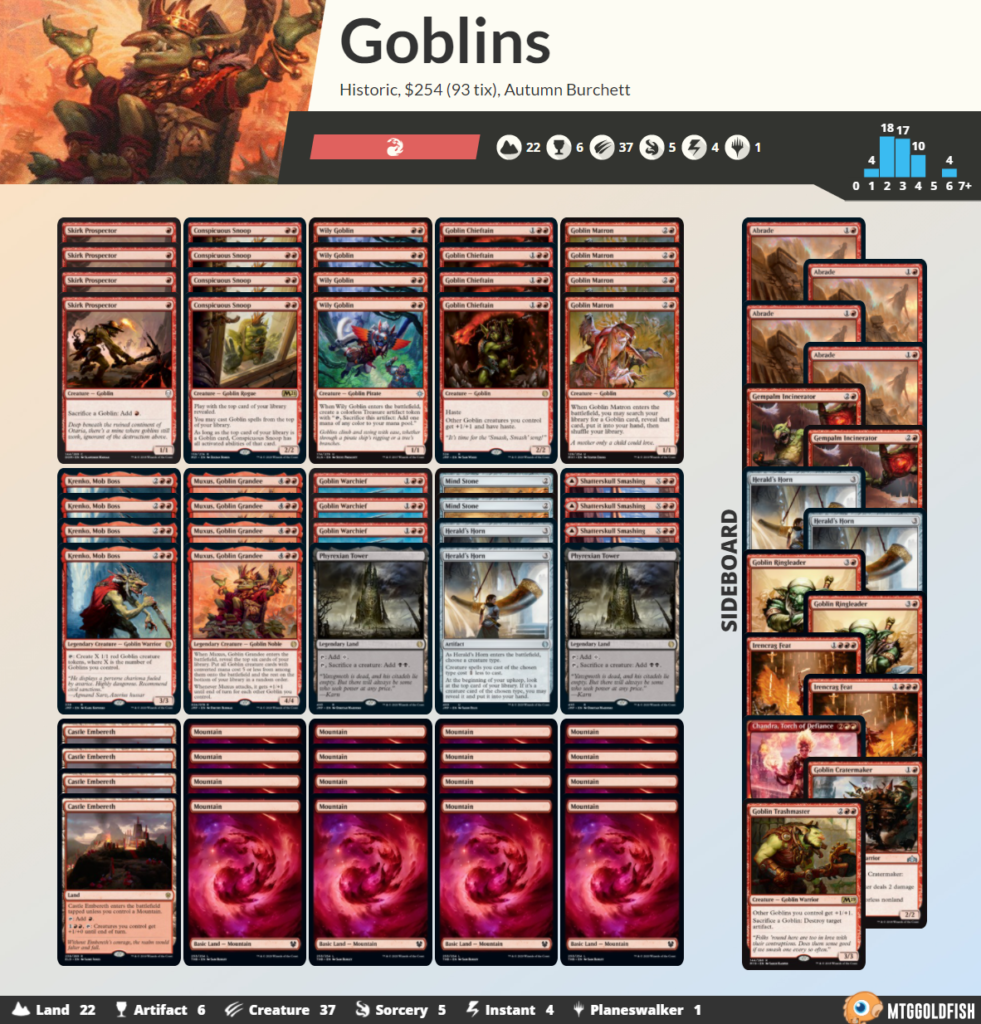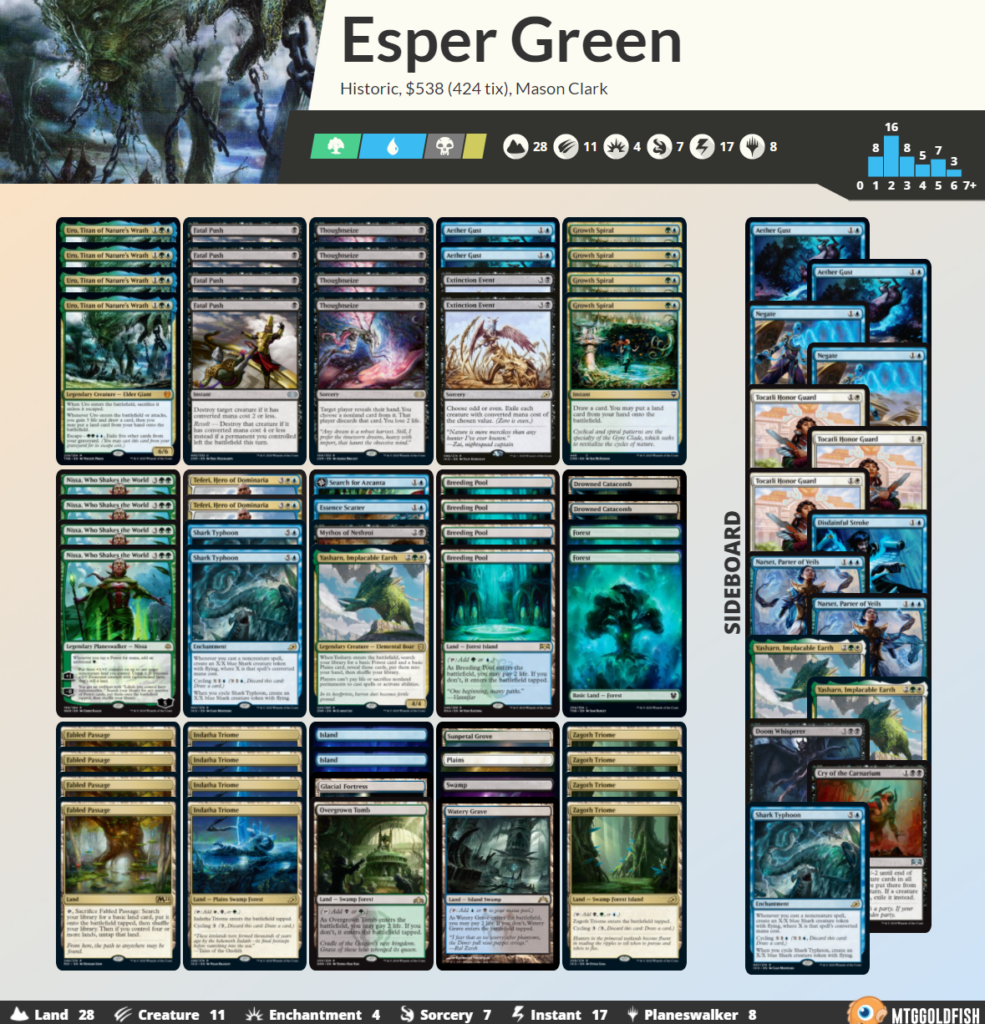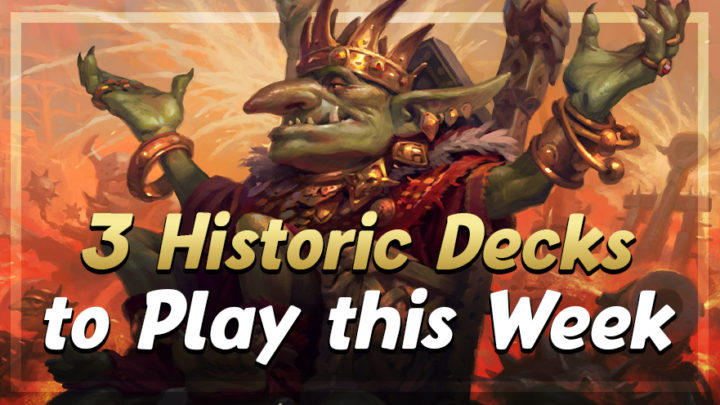The next couple of weeks of Arena play are going to be dominated by Historic. The Arena Open is this weekend, and as its name suggests, anyone can enter on MTG Arena. There’s also a series of Star City Games qualifiers this weekend, plus the Top 1200 Mythic Qualifiers on Arena next weekend.
With all this in mind, I’m going to break down three decks in the format to help you out for the coming weekends of events. If you’ll be playing Historic for the first time or are coming back to the format after a break, this guide will help you get up to speed.
UW Auras

Buy this deck from Card Kingdom
Export this deck to Arena via MTGGoldfish
Auras is a great budget option if you’re just getting into Historic. It can be challenging sometimes to get all the cards you need for this format, especially if you haven’t played Standard consistently for the past few years. The deck is worth picking up for its low wildcard count alone, but it has also consistently proven to be a dark horse of the format. Auras always crushes Arena Open Day Ones, but it has also done well in Best of Three matches. And that’s before the power up it recently got with Kaladesh Remastered!
Auras is a classic beatdown deck. While you do have some disruptive elements post board, your main plan is to get a creature out, put auras on it as quickly as you can, then protect it till you win.
One of the strengths of this deck is its ability to force opponents to play around a vast arsenal of protective spells. The main spells in this category are Alseid of Life’s Bounty and Selfless Savior, which can also wear enchantments if you don’t have any other creatures to attack with. Auras also has a pair of main deck Karametra’s Blessings to help protect our suited-up friends, as well as copies of Dovin’s Veto, Spell Pierce, and Gods Willing in the sideboard.
Another selling point for Auras is its ability to draw cards. Given the nature of Auras, your opponents can easily two-for-one you with removal, making it easy for your opponents to run you out of cards. Kor Spiritdancer and Sram will help you move through the deck and give you a form of velocity that many aggro decks lack. You also get to play Lurrus as your companion, which provides another way to grind through interaction in the late game.
This strategy was much more powerful before Fatal Push entered the format, but it’s still a huge hassle for non-black decks. Even black decks will have a hard time working their way through your protective spells and getting rid of all your creatures. While Auras has a very linear game plan, it will force opponents to play properly and have the right cards for the match-up.
Tips for Playing Auras:
- Think about how your opponents’ interaction will line up with what you’re doing. Does it seem like they’re gearing up for an Extinction Event turn? Try to spread your Auras across even- and odd-costed creatures.
- Don’t be afraid to mulligan. Your deck has some elements of a combo deck, and you need all the right pieces to execute your game plan. No matter how tempting a hand may be, you won’t be able to keep it if it’s missing a creature.
- Plan out how many turns you will need to win. “Clock” is an important thing to keep in mind for any aggressive deck, and especially for this one. Knowing when you need to lower the shields for a turn to cut the clock down versus giving them another turn is a skill you will need to master to unlock this deck’s full potential.
Goblins

Buy this deck from Card Kingdom
Export this deck to Arena via MTGGoldfish
Goblins has been a player in Historic since its introduction in Jumpstart. While its position in the format has varied, it has always had a presence. With the recent innovation of Herald’s Horn and Mind Stone to the main deck thanks to Emma Handy and Autumn Burchett, Goblins has solidified its spot as a huge player going into these weekends.
Goblins is another aggressive deck. However, unlike Auras, your plan is to go wide around the opponent and overwhelm them with small threats. You can enable these types of games with cards like Krenko, Mob Boss, Conspicuous Snoop, and Muxus, Goblin Grandee. Muxus will give you a burst of bodies that will often end with your opponent falling too far behind to win, assuming they didn’t lose that turn. Meanwhile, Krenko and Snoop provide a steadier flow of Goblins, forcing your opponents to have an answer every turn of the game.
Herald’s Horn is one of the newest additions to the deck, and it was instrumental in Autumn Burchett’s success at the Zendikar Rising Championship. Horn allows you to draw up to two cards a turn, while also serving as a cost reduction card. With Horn on the battlefield, you’ll have access to more Goblins, and you can deploy them quickly to overwhelm your opponent.
Horn isn’t the only way this deck can cheat on mana. Skirk Prospector allows you to charge out cards like Muxus before your opponents can even start enacting their plan. The deck also has Wily Goblin to enable plays ahead of schedule, as well as Goblin Warchief, whose cost-reduction and haste-granting abilities allow you to accelerate things another turn.
Mana reduction and card advantage are the keys to Goblins’ success. While your deck is weak to specific cards — such as the increasingly popular Grafdigger’s Cage — your base plan is very powerful and constant. If Muxus hits the battlefield, it’s often lights out for your opponent, since it’s very likely your Goblins will have haste.
Your sideboard can be built in various ways depending on the decks and interaction you’re expecting to face. If you’re expecting Grafdigger’s Cage, you have plenty of options, including Abrade, Goblin Cratermaker, or even additional copies of Herald’s Horn. Goblins can adapt to any hate cards it faces, and most importantly, it can sidestep them thanks to its aggressive game plan.
Tips for Playing Goblins:
- Consider how quickly you can get to Muxus. Playing a Muxus ahead of schedule is your most powerful plan, and keeping a hand that can accelerate you into the six-drop is typically a good plan.
- Think about the hate your opponent will bring in. With open decklists, that won’t be a problem, but for the Arena Open, consider if their deck can afford to play a Grafdigger’s Cage or a Tocatli Honor Guard.
- Don’t be afraid to play a long game. I find a lot of players are worried if the game gets to the middle or late stages with Goblins. Your deck has some real grind potential, and your opponents are going to have a rough time running you out of resources.
4-Color Midrange

Buy this deck from Card Kingdom
Export this deck to Arena via MTGGoldfish
It’s hard to argue that we didn’t save the best for last. Uro piles have taken Historic by storm, with six copies in the Top 8 of the Zendikar Rising Championship alone.
Four of those six decks were 4-Color builds. 4-Color Midrange is a classic midrange deck: your goal is to survive the early game, then play a powerful, game-ending threat that can generate more advantage as the game draws to a close. Unlike the aggro decks we covered earlier, this deck is much more interested in being mana efficient and thwarting what your opponent is doing.
4-Color Midrange plays all the best cards in Historic, including a suite of flexible answers. Thoughtseize and Fatal Push have the lowest costs, which in many ways gives them the highest impact. You can weave these plays into your game plan turn after turn to disrupt your opponent, especially in conjunction with your Explore effects. You also have Mythos of Nethroi as a good catch-all answer to different permanents, while cards like Essence Scatter and Extinction Event will keep your opponents’ creatures in check. You can also easily main-deck Aether Gust — yet another powerful, cheap form of interaction.
Playing all of these cheap interaction spells work perfectly with 4-Color’s main win conditions. Nissa and Teferi often leave you with two mana after using their plus abilities, while Uro often leaves at least one mana left behind after it resolves. When you can play game-ending threats while also protecting them with spells, you’ll be able to take on most of the metagame. The only challenge is to make sure you live long enough to resolve them.
This is where acceleration comes in. Uro and Growth Spiral allow this deck to get ahead on land drops while also smoothing out draws. While there’s no shortage of powerful cards in this deck, these acceleration spells are key to its success; your ability to consistently cast powerful spells ahead of curve is back breaking for many decks.
4-Color Midrange is the deck to beat going into this weekend, and you need a good reason not to play it. It’s hard to argue with any deck that plays all the best cards in the format, especially one that can change plans and adapt post-board.
Tips for Playing 4-Color Midrange:
- You can’t cast your ramp spells if you don’t have enough lands. While you could top deck the land from the draw effect, it’s never guaranteed. I love keeping hands with four lands, Growth Spiral, interaction, and a threat.
- Similarly, be deliberate about how you sequence your land drops. You’re going to need to plan your turns out with this deck, and there is no shame in taking a bit of time to make sure you play your lands in the correct order.
- When sideboarding, remember that many players really don’t like dealing with Uro. This may sound like a meme, but I promise it’s real. So many players will board in a bunch of graveyard hate just to try to beat Uro.
These decks are all serious players and strong choices going into this weekend’s events. While there are easily more decks we could have covered today, these are the three best decks for players who are playing in their first Historic event this weekend.
Have a deck you’re thinking about playing? Tweet it @masoneclark and @card_kingdom and let us know what you’re battling with! Good luck!

Mason Clark is a grinder in every corner of the game who has played at the pro level and on the SCG Tour with Team Nova. Whether he’s competing in Standard, Historic or Modern, Mason plays with one goal in mind: to be a better player than he was the day before. Check out his podcast, Constructed Criticism, and catch his streams on Twitch.

